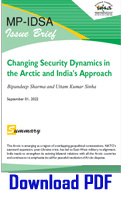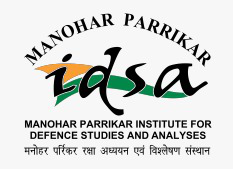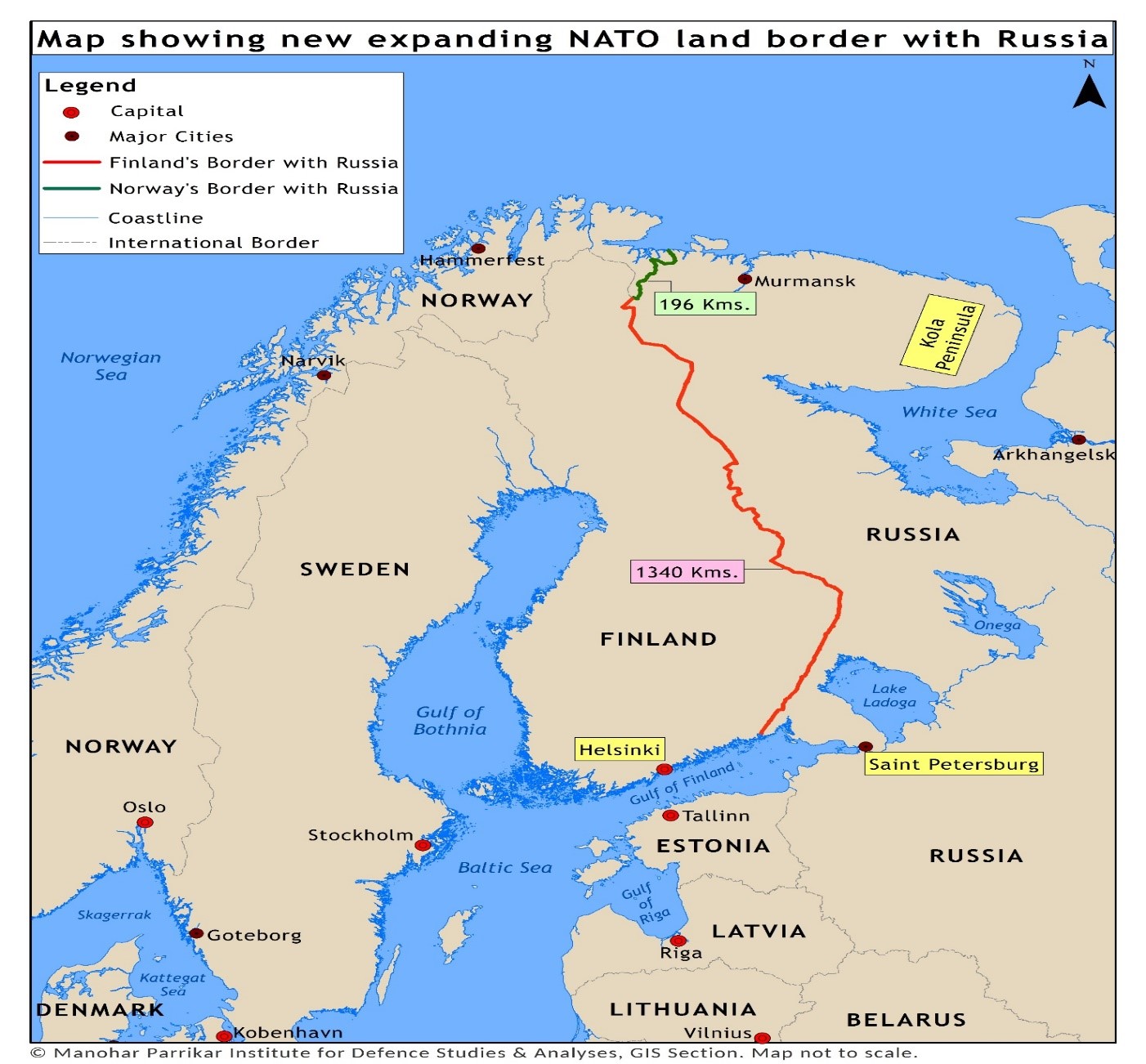Changing Security Dynamics in the Arctic and India’s Approach
Summary
 The Arctic is emerging as a region of overlapping geopolitical contestations. NATO’s eastward expansion, post-Ukraine crisis, has led to East–West military re-alignment. India needs to strengthen its existing bilateral relations with all the Arctic countries and continue to re-emphasize its call for peaceful resolution of Arctic disputes.
The Arctic is emerging as a region of overlapping geopolitical contestations. NATO’s eastward expansion, post-Ukraine crisis, has led to East–West military re-alignment. India needs to strengthen its existing bilateral relations with all the Arctic countries and continue to re-emphasize its call for peaceful resolution of Arctic disputes.
The Arctic region, with its unique yet fragile ecosystem, is undergoing environmental and geopolitical transitions. With the unsettled Ukraine crisis, the Arctic has become a new ‘geopolitical space’ where ‘spillover effects’ of militarisation are undermining the Arctic Council, set up in 1996. The initial decision to consciously keep aside ‘security’ and ‘politics’ from the scope of the Arctic Council resulted in positive outcomes.
However, the recent suspension of Arctic Council or the ‘current temporary pause’ as declared by the Arctic Seven (A7),1 as a response to Russia’s military action in Ukraine, has terminated cooperation between these states.2 A7’s decision to boycott all the meetings and related projects under the Arctic Council chairmanship of Russia has seriously debilitated the functioning of the Council’s six working groups.3 Furthermore, Finland and Sweden’s applications to join the North Atlantic Treaty Organization (NATO) does not bode well for the diplomatic resolution of the Ukraine crisis, nor does it help to keep the peace that Mikhail Gorbachev, the former Secretary-General of the Communist Party of Soviet Union, had championed with his Arctic ‘zone of peace’ initiatives in 1987.
The changing scenario has prompted India, whose primary interests in the Arctic remains scientific, to evaluate the geo-economic and geopolitical prospects in the region. India released its Arctic Policy on 17 March 2022. The document states India’s national priorities from near and long-term perspective. This Brief enunciates how India can pursue its priorities in the Arctic, given the security challenges in the backdrop of the Ukraine crisis.
Geopolitical Complexities
The Arctic region has always remained a zone of strategic importance. During World War II, the Arctic was not unaccustomed to militarism. Subsequently, military activity was part of the set of hostile Cold War global fracturing. Alaska, for example, which was purchased by the US from Russia in 1867, saw the establishment of high level of technology and training facilities. The US built strong defenses east of the Bering Strait.4 Soon it became a shared military space with Canada. A string of radar sites, dubbed the Distant Early Warning Line, was set up in the 1950s to track incoming Soviet planes.
For the Soviet Union, Greenland was its ‘Arctic Backyard’. Moscow considered NATO’s missile deployments in Greenland as a provocative act and a stimulus to arms race. Post Gorbachev’s Murmansk initiative in 1987, the Arctic witnessed substantial reduction in military build-up and several mechanisms to enhance scientific cooperation were developed.5
The de-securitisation phase lasted till 2000. Thereafter, the melting of the Arctic Sea ice and opening up of ‘spaces’ and ‘places’ of economic and strategic importance compelled the Arctic states to make enhanced territorial claims, even beyond their designated Exclusive Economic Zones (EEZ) as per the United Nations Convention on the Law of the Sea (UNCLOS).
The complex interplay of geopolitics with emerging geo-economics is rapidly propelling the Arctic towards re-securitisation. Canada recently announced its commitment to upgrade the Arctic defence and modernize its North American Aerospace Defense Command (NORAD) capabilities. The US, too, plans to have an Arctic ambassador. For the first time since the establishment of the Arctic Council, the region is witnessing complete breakdown of cooperation between Russia and the western Arctic states. While political disparities and discord existed in the post-Cold War period, cooperation was never terminated.
Finland and Sweden’s NATO Membership
The US’ signing of the ‘instrument of ratification’ on 9 August 2022 endorsing Finland and Sweden’s accession to NATO.6 The accession now needs to be ratified by the parliaments of all the 30 NATO members. While the ratification process could take several months, intensive security cooperation between the NATO members and the two Nordic countries have already begun. In the past, Finland and Sweden regularly participated in NATO military exercises in the region and sent their troops to NATO peacekeeping missions in Afghanistan, the Balkans, and Iraq.7 Further, all the five Nordic countries (out of which Denmark, Iceland and Norway are existing NATO members) also maintain close bilateral and multilateral relations with one another.
Finland and Sweden’s membership of NATO is bound to impact the geostrategic security scenario in the Arctic. First, of the eight Arctic countries within the Arctic Circle (i.e., region above 66° 33’ 44’’ north), five are existing NATO members (Canada, Denmark, Iceland, Norway and United States). With Finland and Sweden’s decision to join NATO, the new security equation in the Arctic will squarely be tilted in favour of the western NATO members with Russia on the other side as the non-NATO member. Practically, this could result in the development and implementation of a new ‘NATO Arctic Policy’ with strategic and security objectives. The changed arrangement may instigate similar counter-response from Russia which could escalate strategic military posturing in the region.
Second, till recently, Russia shared 196 km of direct land border with only one NATO member state, i.e., Norway. Finland joining NATO would result in the addition of 1,340 km of land borders between NATO and Russia. This would drastically alter the strategic threat perception of Russia, owning to the geographical proximity between Helsinki and Russia’s important cities such as St. Petersburg and its key strategic base on the Kola Peninsula, which is the linchpin of its military establishment in the western Arctic.
The Russia–Finland border that remained peaceful since World War II, could witness permanent military presence and deployment of excessive military infrastructure. The severity of this could be analysed from Russian President Vladimir Putin’s statement in Turkmenistan emphasising that Russia does not have any territorial or other issues with Sweden and Finland like the one it has with Ukraine. But he simultaneously asserted that “if military contingents and military infrastructure were deployed there, we would be obliged to respond symmetrically and raise the same threats for those territories where threats have arisen for us”.8
The neutral status of Finland and Sweden, which till recently acted as a buffer between NATO and Russia, will no longer hold. While on the one hand, their accession has strengthened NATO positioning in the Arctic, on the other, it has simultaneously resulted in greater instability in the Arctic region. This could trigger greater military build-ups where even a small military miscalculation could result in military standoffs. Such a scenario could not only escalate East–West tensions in the Arctic, but would also directly challenge Europe’s overall security dynamics in the near future.
India’s Approach and Way Forward
India’s Arctic Policy asserts that the Arctic region remains of utmost importance from the scientific, geo-economic and geostrategic perspectives. India maintains a Vedic connect with the Arctic region. India’s modern scientific engagements in the Arctic started in 2007 with the establishment of its first permanent scientific research station, Himadri at Svalbard, Norway. Since then, ‘scientific research’ and the study of ‘teleconnection links between Arctic ice melting and variations in Indian monsoons’ has remained key priority areas.
With the rising global temperatures, India’s national interest in the region has matured over time and also broadened in its scope from a scientific to include a wider geo-economic and geopolitical perspective. India’s Arctic Policy rests on six key pillars through which it aims to prioritise its future engagement.9 Undoubtedly, the Ukraine crisis and the ongoing geopolitical transition have impacted the pace of India’s Arctic engagement. In the light of the changes, India needs a calibrated approach to accomplish its national objectives in the region.
Science and Climate Change
Scientific and climate change research remains vital for India, particularly in understanding the changes in the Indian monsoons and their teleconnection link between the Arctic, Antarctic and the Himalayas (or the Third Pole). The termination of scientific cooperation and sanctions and restrictions imposed by the Western countries, as a result of the Ukraine crisis, have significantly impacted research and data sharing relating to the Russian Arctic.10
India maintains independent bilateral relations with Russia and all the other Arctic countries. It further needs to enhance these partnerships and broaden its collaboration with academic, social, governmental and non-governmental organisations in the respective countries. Indian universities and academic institutions undertaking polar scientific research can play a critical role by building knowledge bridges with Arctic universities and institutions of global excellence. Such initiatives can serve as an important link between the East and West on matters of scientific and climate research that impact humankind.
‘Space technology’ that finds specific mention in India’s Arctic Policy could become an important game-changer in the region. The Arctic severely lacks space-based infrastructure that is required for telecommunication, connectivity, navigation, search and rescue, climate modelling, environment monitoring, surveillance and various related domains.11 India maintains advanced space-based capabilities and provides global services in launching cost-efficient satellite solutions. India maintains space-based cooperation with Russia and the United States. This, however, needs to be enhanced with other Arctic countries bilaterally, multilaterally and also on ‘client–seller’ relationship basis.
Economic and Human Development
India’s growing need for hydrocarbons and energy resources makes the Arctic region important for the country. Scientific estimates predict that the Arctic region accounts for 90 billion barrels of oil, 1,669 trillion cubic feet of natural gas, and 44 billion barrels of natural gas liquids.12 India has made investments in Russian energy projects, but continuous discoveries of new oil and gas fields in the region offers new opportunities in terms of harnessing hydrocarbon potential of the region.
The Arctic region also remains important as rare earth minerals that are of strategic value are found in the region. Critical metals such as Cobalt, Copper, Lithium, Lead, Nickel, Niobium, Phosphorus, and various Platinum-group elements that are required in manufacturing of critical defence equipment, clean technologies such as solar panels, wind turbines, batteries of electric vehicles and various other sectors, are abundantly available in the Arctic region.13 India is pushing for developing clean energy solutions to meet its climate commitments in the near future. India needs to assess its emerging demand of critical minerals and develop adequate mechanism for public/private investment in Arctic states like Greenland (Denmark) that are abundant with such resources.
India’s ‘One Sun One World One Grid’ (OSOWOG) initiative launched at COP26 in Glasgow, could also have its polar dimension. All the eight Arctic countries witness six months of continuous sunlight. Linking all the Arctic states with OSOWOG can provide a new platform for cooperation amongst these states. On the other hand, it would significantly reduce their carbon footprints and would contribute towards their Intended Nationally Determined Contribution (INDC) targets. Currently, out of the eight Arctic states, Norway, Sweden and Denmark have signed and ratified the International Solar Alliance (ISA) while the US has recently become a signatory state.14 India should further aim at bringing Canada, Finland and Russia into the alliance through which the Arctic region can make a significant difference in harnessing solar energy.
Transportation and Connectivity
Shrinking of the Arctic Sea ice due to climate change is encouraging the growth of maritime traffic. The Northern Sea Route (NSR) along the Russian coast has the potential of cutting travel distance between European and Asian markets by 40 per cent.15 The NSR, in comparison to China and Japan, does not offer great prospects for India vis-à-vis Europe. However, as Russia’s Far East region develops from Bering Sea to Vladivostok, connecting this route to Indian east coast ports could potentially open new trade avenues for both India and Russia. Apart from the development of the NSR, Russia has expanded its railway networks to enable access to the Arctic Ocean and accelerate the development of the Russian Arctic, particularly the Murmansk.16
Such long-term Russian transport strategy gives fillip to the International North–South Transport Corridor (INSTC) which is a priority for India, and the sanctions-hit Iran and Russia. Not surprisingly, the INSTC has facilitated a higher volume of trade between India and Russia via Iran in recent months. Speaking at the recent Sixth Caspian Sea Summit, Putin described the INSTC as a “transport artery from St Petersburg to ports in Iran and India”.17
The NSR and the INSTC would enable direct connectivity between Murmansk and Mumbai ports. The Murmansk port also maintains easy connectivity with the Norwegian port of Kirkenes. Once fully operational, INSTC could not only enable India’s alternate connectivity with Russia, but also with other Arctic countries like Finland and Norway. Transportation and connectivity that remain important components of India’s Arctic policy need to be developed by following a multifaceted approach in the region. Russia remains a crucial partner for India, but equal partnerships also need to be explored with other Arctic states.
International Cooperation
The Arctic Council, the only existing mechanism for cooperation in the region, remains currently suspended. Scientific activities have taken a backseat. The non-Arctic states/observers in the Arctic Council are in a conundrum regarding the future status of the Council. The arguments for the continued working of the Arctic Council ‘without’ Russia further add to the geopolitical complexities.18 Any such unilateral call would not only widen the insecurity gap, but could also result in split amongst non-Arctic states in the Council.
Russia holds the largest territorial extent in the Arctic and accounts for more than 52 per cent of the total Arctic coastline. It is by far the largest Arctic state in terms of geographical size, population and military forces.19 Therefore, any counter-alliance formation by Russia with Asian partners like China in the Arctic, would jeopardise Arctic cooperation and spiral the region into extreme uncertainties.
India should call for reviving the Arctic Council as per the fundamental principles of Ottawa Declaration20 that called for promoting cooperation, coordination and interaction among Arctic states and its indigenous communities on issues of sustainable development and environmental protection. Simultaneously, to meet its own Arctic priorities, India needs to invest in developing its independent polar infrastructure and research base in the region. Developing cooperation with Arctic countries having polar expertise also remains crucial to India’s continued engagement.
Conclusion
The Arctic is emerging as a region of overlapping geopolitical contestations. NATO’s eastward expansion, post-Ukraine crisis, has brought securitisation upfront with East–West military re-alignment. With Finland and Sweden’s application for membership to NATO and presumed isolation of Russia have led to greater insecurities in the region. In the changing scenario, India, as an Observer Member in the Arctic Council, needs to carefully align its national priorities in the region. In order to achieve these objectives, India needs to develop independent mechanisms to strengthen its existing bilateral relations with all the Arctic countries. This needs to be done in a calibrated and non-judgmental and non-prejudicial way. Finally, India should continue to re-emphasize its call for peaceful resolution of Arctic disputes and promote its traditional philosophy of Vasudhaiva Kutumbakam (the world is but one family) in the Arctic.
Views expressed are of the author and do not necessarily reflect the views of the Manohar Parrrikar IDSA or of the Government of India.
- 1. Canada, Denmark (Greenland), Finland, Iceland, Norway, Sweden and the United States.
- 2. “Joint Statement on Arctic Council Cooperation Following Russia’s Invasion of Ukraine”, US Department of State, 3 March 2022.
- 3. “Working Groups”, Arctic Council.
- 4. Matthew Farish, “The Lab and the Land: Overcoming the Arctic in Cold War Alaska”, Isis: A Journal of the History of Science Society, Vol. 104, No. 1, March 2013.
- 5. Kristian Åtland, “Mikhail Gorbachev, the Murmansk Initiative, and the De-securitization of Interstate Relations in the Arctic”, Cooperation and Conflict, Vol. 43, No. 3, 1 September 2008.
- 6. Jeff Mason and Patricia Zengerle, “Biden Signs Documents of U.S. Support for Sweden, Finland to Join NATO”, Reuters, 10 August 2022.
- 7. Luke Coffey and Daniel Kochis, “Finland’s and Sweden’s NATO Accession is in the National Interest and Should Receive Senate Support”, The Heritage Foundation, Issue Brief No. 5269, 26 May 2022.
- 8. Andrew Roth, “Putin Issues Fresh Warning to Finland and Sweden on Installing NATO Infrastructure”, The Guardian, 29 June 2022.
- 9. “India’s Arctic Policy: Building a Partnership for Sustainable Development”, Ministry of Earth Sciences, Government of India, 17 March 2022, p. 9.
- 10. “For the Climate’s Sake, Keep Arctic Communication Open”, Nature, 20 July 2022.
- 11. Alla Pozdnakova, “Space Infrastructure for a Sustainable Arctic: Opportunities and Challenges of Spaceport Development in the High North”, The Arctic Institute, 31 May 2022.
- 12. “Circum-Arctic Resource Appraisal: Estimates of Undiscovered Oil and Gas North of the Arctic Circle”, United States Geological Survey, 2008.
- 13. Sergey V. Krivovichev, “Arctic Mineral Resources: Science and Technology”, Multidisciplinary Digital Publishing Institute, 2019.
- 14. “Countries Who Have Signed and Ratified the ISA Framework Agreement”, International Solar Alliance.
- 15. Stavros Karamperidis and Nikolaos Valantasis-Kanellos, “Northern Sea Route as an Emerging Option for Global Transport Networks: A Policy Perspective”, WMU Journal of Maritime Affairs, 30 May 2022.
- 16. Ebru Caymaz, “Enhancing Industrial Development in the Russian Arctic: The Northern Latitudinal Passage”, The Arctic Institute, 5 April 2022.
- 17. “6th Caspian Summit”, President of Russia, 29 June 2022.
- 18. Melody Schreiber, “Arctic Council Nations to Resume Limited Cooperation — Without Russia”, Arctic Today, 8 June 2022.
- 19. Benjamin J. Sacks and Kristin Van Abel, “Op-Ed: How the Ukraine War Puts the Arctic At Risk”, Los Angeles Times, 22 August 2022.
- 20. “Declaration on the Establishment of the Arctic Council”, Arctic Council, Ottawa, Canada, 19 September 1996.






